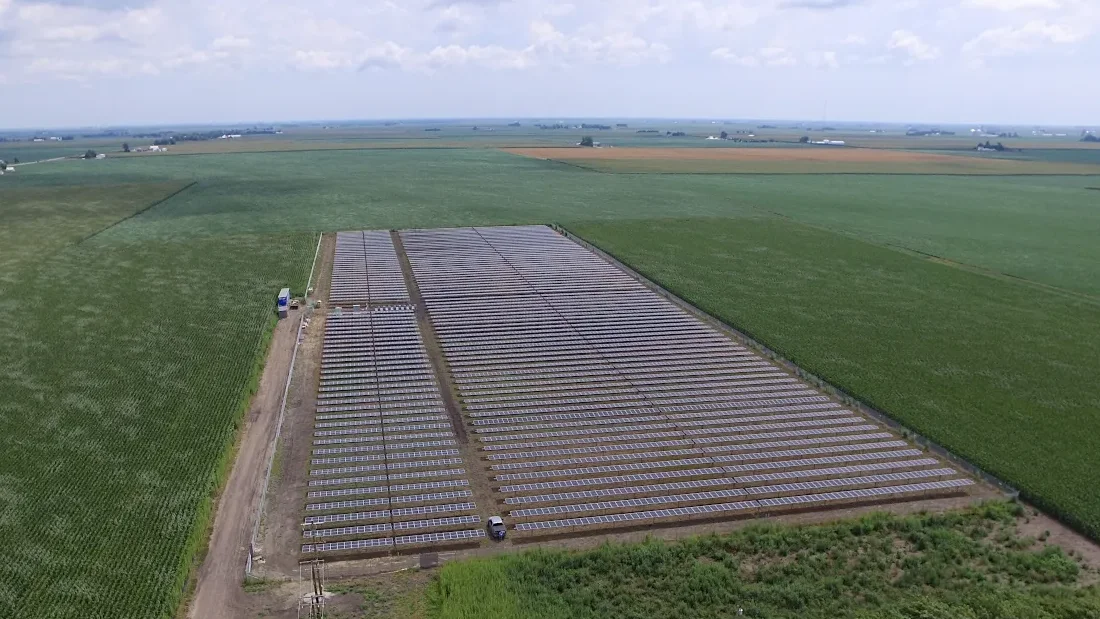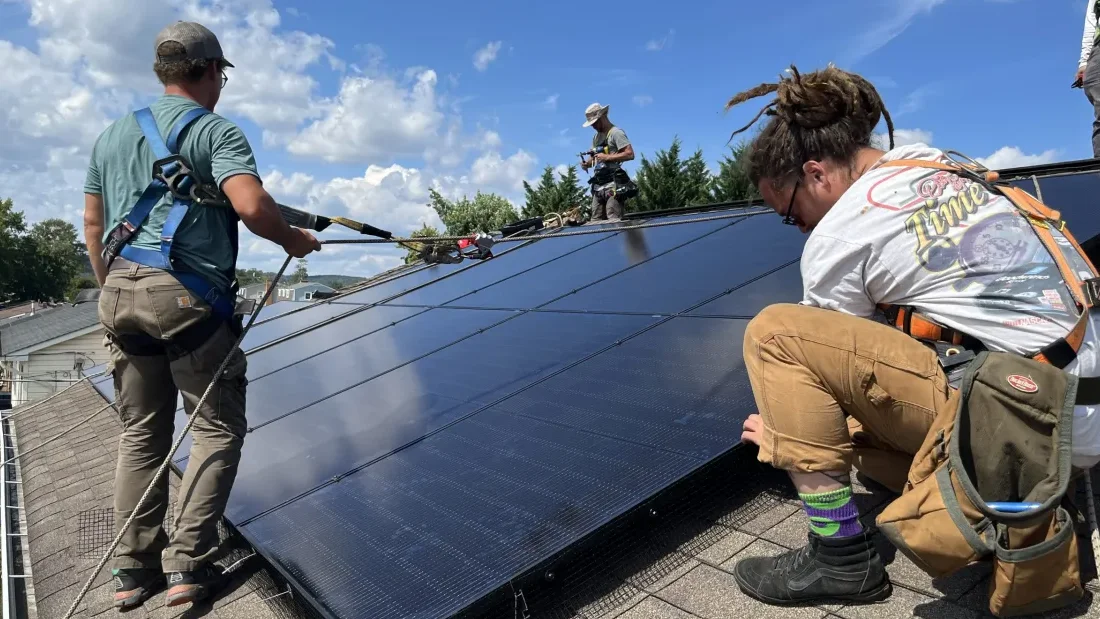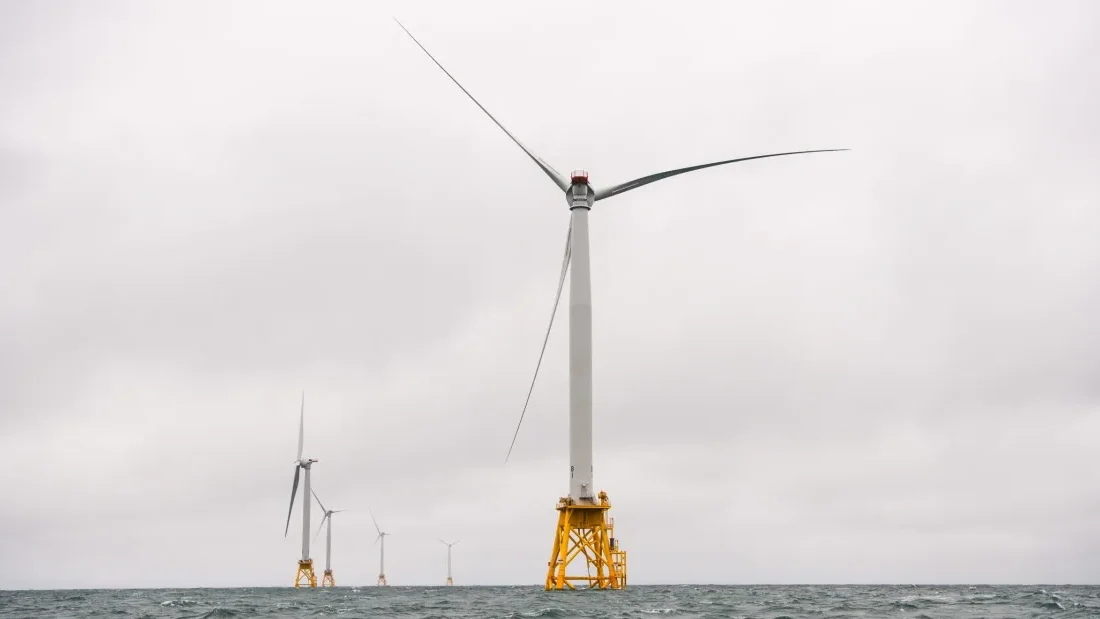
GEOTHERMAL: Boston’s mayor briefly mentions a major new utility project in her State of the City speech: the city’s first networked geothermal heating and cooling system, to be developed by National Grid in the Franklin Field neighborhood. (WCVB)
BUILDINGS: In her annual speech, Boston’s mayor also announced a new program to ban new city-owned buildings from using fossil fuels. (Boston Globe)
GRID:
FOSSIL FUELS: PJM Interconnection wants Talen Energy to postpone the planned decommissioning of two units at a 840 MW coal, oil and gas-fired Maryland power plant, citing pending transmission upgrades. (POWER Magazine)
CLEAN ENERGY:
OFFSHORE WIND: A Rhode Island senator proposes a new federal bill to clarify and streamline the offshore wind development pipeline process. (ecoRI)
REGULATION:
ELECTRIC VEHICLES:
CLIMATE: Maine’s state climatologist says climate change is the main reason every season over the last century has seen more precipitation. (Portland Press Herald)

TRANSITION: An energy company’s plan to build an 800 MW solar farm on a 27,000-acre mountaintop removal mine site in Kentucky could become a model to repurpose environmentally disturbed sites in Appalachia for renewables. (Daily Yonder)
ALSO: Federal investigators will look into Appalachia’s “zombie mines,” where coal production has ceased but which companies say are “active” to avoid reclamation costs. (Inside Climate News)
GRID:
ELECTRIC VEHICLES:
SOLAR:
OIL & GAS:
CLIMATE:
UTILITIES: Arkansas power and natural gas utilities respond to state regulators’ questions about their plans to use federal funding for energy efficiency and grid infrastructure projects. (Arkansas Business)
POLITICS: Activists wielding leaf blowers gather outside the Virginia Capitol to lobby for legislation that would let local governments regulate gas-powered blowers. (Richmond Times-Dispatch)
COMMENTARY: An environmental justice advocate calls for pop star and real estate developer Pharrell Williams to consider the risk of climate gentrification to nearby Black neighborhoods as he moves forward with projects in coastal Virginia. (Daily Press)

Community solar could be an important tool to lower electricity bills and bring clean energy to low-income communities. But even as federal incentives aim to lower the cost of building community solar arrays, big issues still stand in the way, advocates tell the Energy News Network.
When a community solar array is built, people in the area can sign up to receive electricity that’s often cleaner and cheaper than what they’d get from their utility. It’s ideal for residents who can’t put solar on their own roofs because of installation costs or other reasons.
Incentives introduced under the Inflation Reduction Act aim to boost community solar, with extra tax credits slated for arrays that benefit low-income people and areas. But it’s not easy to qualify a household as low-income. The process varies from state to state, but it often requires that people provide tax returns and other documentation to prove their income — something that could make customers reluctant to buy in.
Federal law does try to tackle this problem by letting LIHEAP eligibility count as a measure of eligibility for low-income community solar bonuses. The low-income heating assistance program has been around for decades, so it’s more familiar to many people. States can also designate whole areas as low-income to smooth the process.
Read more about the challenges holding up community solar, plus some solutions that are rolling out, at the Energy News Network.
🚌 New school: The U.S. EPA announces nearly $1 billion in grants for schools to replace diesel buses with electric and low-emissions vehicles, with a vast majority going to schools in low-income, rural and tribal communities. (Guardian)
⚡ The grid’s big year: 2024 could be a make-or-break year for lawmakers, regulators and utilities to push through federal reforms aimed at making it quicker and easier to expand the power grid. (Canary Media)
💰 What’s stopping decarbonization: Upfront cost is the biggest barrier keeping people from making home energy upgrades like swapping out gas stoves, while lowering energy costs and environmental impact is a top motivator, a survey finds. (Canary Media)
🔋 The sunshine neighborhood: Every residence in an 86-home Florida development comes with solar panels and a home battery, ensuring none of its homeowners pay electric bills and offering a model for sustainable building. (Washington Post)
☀️ Solar tax swap: First Solar enters two deals to sell $700 million worth of federal tax credits, a first-of-its-kind transaction that will let the U.S. solar panel manufacturer quickly bring in money from domestic production incentives it could otherwise only use to trim its tax bill. (Canary Media)
🚙 Big cars, big emissions: Several automakers’ average fuel efficiency dropped from 2017 to 2022, largely because of the growing popularity of SUVs and pickup trucks. (Washington Post)
🔌 The EV incentives list is here: The federal government published a list of electric vehicles that qualify for $7,500 and $3,750 incentives, which can now be redeemed at thousands of dealerships. (Inside Climate News)
🏗️ Gas bans meet their end: A federal appeals court reaffirms its decision to strike down Berkeley, California’s ban on gas hookups in new buildings, invalidating other local gas bans in the 9th Circuit’s territory of 11 Western states. (Grist)
🥾 Electrifying tourism: An Alaska carbon offset program uses tourists’ donations to purchase electric heat pumps for local residents. (Grist)

EQUITY: Low-income households could benefit most from clean energy upgrades such as heat pumps and solar panels but often don’t have access to financing or government incentives. (New York Times)
SOLAR: The U.S. Energy Information Administration predicts 79 GW of new solar capacity will come online through the end of 2025, potentially making it the top source of power growth over the next two years. (Utility Dive)
STORAGE: Federal analysts also predict energy storage on the grid will nearly double this year, from 17.3 GW now to 31.1 GW by December. (Canary Media)
OIL & GAS:
HYDROGEN: The Biden administration’s proposed hydrogen incentive rules place strict emissions limits on green hydrogen producers but lack standards for natural gas-sourced blue hydrogen. (Canary Media)
COAL:
ELECTRIC VEHICLES:
CLIMATE: Climate-fueled storms, flooding and rising sea levels are bound to drive coastal U.S. residents inland, but elderly people are likely to be left behind, a study finds. (Grist)
POLITICS: The planned departure of several longtime U.S. House and Senate members who have played key roles in energy policy raises concerns about brain drain with the loss of their institutional knowledge on issues. (E&E News)
COMMENTARY: A clean energy columnist calls on journalists to stop sensationalizing clean energy-related bird deaths, pointing to a study finding oil and gas drilling is more harmful to avians than wind turbines. (Los Angeles Times)

NATURAL GAS: An energy company shutters a natural gas power plant in southern California after a city lobbies for decades to have it decommissioned. (Daily Breeze)
ALSO:
OIL & GAS:
BIOFUELS: Portland, Oregon, approves three proposed biodiesel pipelines at a fossil fuel terminal on the Willamette River as part of a company’s agreement to phase out crude oil storage at the facility. (Oregonian)
POLLUTION:
SOLAR: California advocates ask an appeals court to rehear their challenge of the state’s new net-metering policy slashing compensation for energy generated by rooftop solar. (San Diego Union-Tribune)
CLIMATE: A federal report finds the waters off Alaska’s Aleutian Islands registered the warmest winter temperatures in over a century, making the ecosystem a “bellwether for climate change.” (Alaska Beacon)
ELECTRIC VEHICLES: Federal labor regulators accuse California electric vehicle startup Lucid of illegally firing two employees for joining the United Auto Workers union. (Los Angeles Times)
URANIUM: The federal Bureau of Land Management permits a uranium mining company to begin exploratory drilling just outside Bears Ears National Monument in southern Utah. (Mining Technology)
PUBLIC LANDS: The federal Bureau of Land Management seeks public input on a proposal to lift some environmental protections from 28 million acres in Alaska. (Nome Nugget)
COMMENTARY: A California energy columnist urges readers to see the world through “climate-colored goggles” because human-caused global warming is pressing, immediate and terrifying. (Los Angeles Times)

HYDROGEN: The Treasury Department’s new hydrogen tax credit guidelines appear to favor Texas and states in the Midwest and Southwest, where wind and solar can be built quickly and cheaply. (Canary Media)
ALSO: The new hydrogen incentive rules raise questions about how the federal government will measure the industry’s emissions and account for the use of nuclear power and carbon capture in hydrogen production. (E&E News)
SOLAR: First Solar enters two deals to sell $700 million worth of tax credits, a first-of-its-kind transaction that will let the U.S. solar panel manufacturer quickly bring in money from the federal domestic production incentives it could otherwise only use to trim its tax bill. (Canary Media)
WIND:
STORAGE:
CLIMATE: A judge rejects a U.S. Justice Department bid to dismiss an Oregon youths’ lawsuit alleging federal policies contribute to human-caused climate change, allowing the case to move forward. (OPB)
CARBON CAPTURE: Communities across south Louisiana organize to oppose at least 20 underground carbon dioxide storage projects in the planning or development stages that also include a sprawling network of pipeline expansions. (Floodlight/WWNO)
ELECTRIC VEHICLES: Georgia saw a surge of electric vehicle and battery-related investment in 2023, driven by ongoing construction at Hyundai’s electric vehicle factory and amplified by federal funding and tax credits. (Atlanta Journal-Constitution, Savannah Tribune)
OIL & GAS: New Mexico lawmakers consider legislation that would ban new oil and gas drilling and phase out most existing production within one mile of schools and daycare centers. (Associated Press)
EFFICIENCY:

WIND: Louisville Gas and Electric and Kentucky Utilities build a utility-scale wind turbine in Kentucky to test the potential for wind power in the state. (Kentucky Lantern)
ELECTRIC VEHICLES:
SOLAR:
CARBON CAPTURE: Communities across south Louisiana organize to oppose at least 20 underground carbon dioxide storage projects in the planning or development stages that also include a sprawling network of pipeline expansions. (Floodlight/WWNO)
OIL & GAS:
GRID:
CLIMATE: A federal report on damage done by 2022’s Hurricane Ian finds newer homes survive better than older homes, with newer roofs as the single most important upgrade in damage assessments. (Miami Herald)
CLEAN ENERGY: A South Korean electronics company announces it will invest $700 million into West Virginia to develop renewable energy, telehealth and other technologies. (Associated Press)
HYDROGEN: Newly proposed rules governing development of the “green hydrogen” industry appear to favor Texas and states in the Midwest and Southwest, where wind and solar can be built quickly and cheaply. (Canary Media)
ENVIRONMENTAL JUSTICE: The U.S. EPA awards $50 million to environmental and climate justice organizations from New Orleans and Houston to reduce greenhouse gases and clean up their communities. (Verite News)
OVERSIGHT: Louisiana Gov.-elect Jeff Landry names an oil and gas industry executive to head up the state’s Department of Natural Resources. (NOLA.com)
WORKFORCE: A Texas nonprofit trains workers for the solar industry as part of its mission of “disrupting poverty through green career training.” (Dallas Free Press)
COMMENTARY: Louisiana is gearing up for a legal fight against a federal policy that could dramatically reduce greenhouse gas emissions even as the state tries to preserve its coastline against rising seas, writes a columnist. (NOLA.com)

OIL & GAS: A $25 million federal grant allowed Michigan to plug 200 orphaned oil and gas wells in 2023, nearly half of all known orphaned wells in the state. (MLive)
WASTE-TO-ENERGY: Youngstown, Ohio, officials halt plans for a facility that would convert recycled tires into synthetic gas in a neighborhood of predominantly Black residents. (Inside Climate News)
PIPELINES:
GRID:
SOLAR: Officials in southern Illinois advance plans to purchase a vacant, 123-acre cemetery that’s owned by the state for a solar project. (FOX 2)
RENEWABLES: Indiana-based NiSource sells a minority stake in its utility NIPSCO for $2.16 billion that executives say will help the utility invest in more renewables. (Times of Northwest Indiana)
COAL: The owner of North Dakota’s largest coal plant, which is set to close in the coming years, expands a partnership to recycle more byproducts from coal burning for future uses. (Bismarck Tribune)
OVERSIGHT: The U.S. Supreme Court and federal district courts are weighing several cases this year that could significantly limit federal energy regulators’ ability to oversee climate and infrastructure policy. (E&E News)
WIND: Consumers Energy begins operating a 72-turbine, 201 MW wind project in central Michigan. (FOX 17)
EMISSIONS: A northern Michigan city hopes to reduce its local methane emissions by enrolling more restaurants in a composting program that diverts food waste from landfills. (WDIV)
UTILITIES: Minnesota utilities continue seeking rate increases for grid investments and clean energy as inflation on services remains stubborn for consumers. (Star Tribune)

HYDROGEN: The Biden administration releases guidance for its hydrogen tax credit, though industry leaders say the rules go too far in prioritizing low- and zero-emission hydrogen production and will slow growth. (E&E News, Utility Dive)
ELECTRIC VEHICLES:
SOLAR: Solar advocates in Georgia and elsewhere embrace federal funding for programs to reduce energy bills by making solar power affordable for lower-income households. (WABE/Grist)
CLEAN ENERGY:
CLIMATE:
EMISSIONS:
PIPELINES: A proposed carbon pipeline in the Midwest divides ethanol industry supporters and farmers who say they feel betrayed by the company’s potential use of eminent domain to build the project. (South Dakota Searchlight)
GRID:
LITHIUM: The Reno-Sparks Indian Colony looks to build coalitions and garner public support — rather than file lawsuits — to fight the Thacker Pass lithium mine in Nevada. (Associated Press)
RESILIENCY: Although Massachusetts wants more municipalities to undertake climate resiliency projects, they say securing state funds to do so isn’t easy. (Boston Globe)
BUILDINGS: Maine’s heat pump market is already thriving, but new federal subsidies targeting low-income homeowners could further spur its growth. (Portland Press Herald)

CLEAN ENERGY: A $10 million federal grant will support economic development efforts in Ohio and neighboring states to help lure small- and medium-sized manufacturers specializing in the clean energy supply chain. (Energy News Network)
CO2 PIPELINES:
OHIO: The former FirstEnergy subsidiary that was to receive the bulk of a ratepayer-funded bailout for two of its nuclear plants says it acted in a “legal way” to help get House Bill 6 passed. (Ohio Capital Journal)
SOLAR:
PIPELINES: Environmental groups and four tribes will appeal Michigan regulators’ decision to allow plans for an underground tunnel for Line 5 in the Straits of Mackinac. (MLive)
OIL & GAS:
BIOGAS: Plans for a central Wisconsin anaerobic digester on a dairy farm divide local residents as critics raise groundwater pollution concerns. (Wisconsin Examiner)
COAL: Decommissioning units of a Wisconsin coal plant in the coming months will require complex steps to keep wastewater treatment, water intake and a conveyor system operational for remaining units. (Journal Sentinel)
UTILITIES: A new Illinois law that took effect on Jan. 1 prohibits utilities from shutting off power to customers when temperatures reach certain heat thresholds. (Southern Illinoisan)
GRID: North Dakota Gov. Doug Burgum declared a statewide emergency on Friday as thousands of residents experienced power outages when an ice storm dismantled power lines. (Associated Press)
CLIMATE: A new documentary explores researchers’ and advocates’ efforts to find climate solutions in northern Michigan. (Michigan Advance)